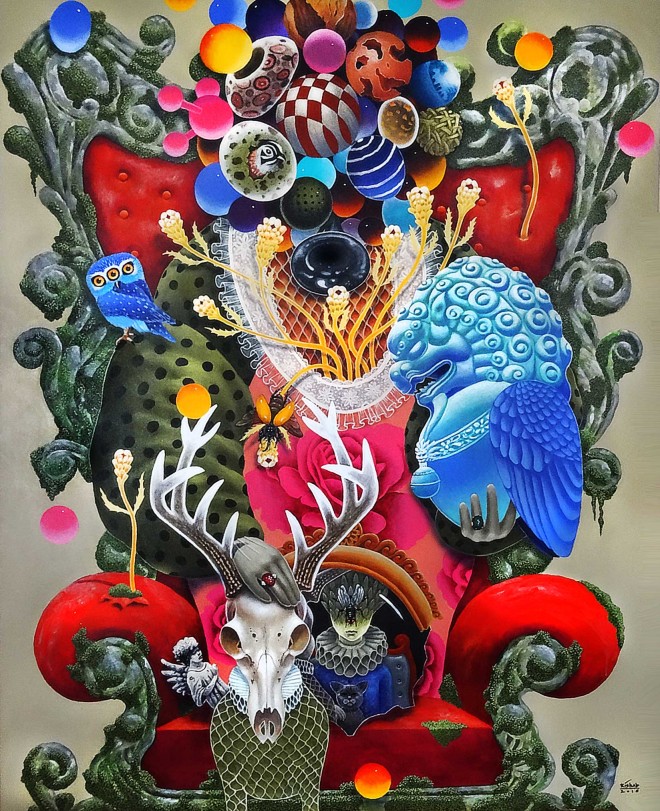
Enchantment is what one is filled with when faced by the works of Roger “Rishab” Tibon.
To be sure, Rishab’s technique is riveting, a sharpened instrument of virtuosity in itself, capable of executing his wildest imagination, seemingly inexhaustible in the energy and enthusiasm that drives the finest delineation of his most complex compositions. If God is in the details, then there is a multitude of angels dancing on the tip of Rishab’s pen.
Recently on view at the Art Elements Gallery was Rishab’s solo show titled “Lucid Dreamings,” as delightfully hallucinatory as ever delighted the eyes, brimming with a dense agglomeration of images now familiar to his audience, with their magical capacity to transfix us with a highly personal vision: the world according to Rishab.
Each image is rendered at its most ornamental, with a quality of existence that can only be described as “orchidaceous,” so sheerly over-the-top is the aesthetics that gladden the heart and eyes even before the mind could make sense of the lush iconography. Rishab’s paintings then are like visual perfume, capable of flooding the senses and scenting the air that surrounds them.
Flower power
Rishab tends to his composition much as a gardener would. Like a presiding spirit, the artist constructs his compositions as though they were bouquets made for a sacramental offering. They are at once “cultivated” and “wild.” Give any of his works the “Squint Test” and they would, from a distance, strike the eye as an apparition in a garden, complete with mossy walls and climbing trellises and concrete sculptures straight out of Disneyland. The aptly titled “Dance of Nature” makes us intimate with the presence of insects and butterflies, befriending owl and doe, in an ambience of spirited movement suggesting the rhythms of nature.
Flowers, of course, are at the heart of Rishab’s art. It is this subject which Rishab totally inhabits, and is the image that is the source of his visual momentum. Two works in the show are focused on the subject: “Cherry Blossoms” with the exotic charm of Japonaiserie and the infectious pop joviality of the Japanese anime.
The other is “Lotus,” based of course on the lotus flower, the national flower of India and Egypt, signifying elegance and beauty, purity and grace. In this work, there is a central dominant figure which one may well imagine to be the Hindu goddess Lakshmi but attired in a harlequin’s costume. Her face is an unfolding of petals—where shades of pink never seemed more profound and feminine. Around her is a swirling juxtaposition of butterflies and birds and goldfish, all that in Rishab’s trademark stylistic panache, a visual vanity of pastel shades and pure, crystalline line.
Intriguingly, there are two works that make use of a throne, at any rate an ornately capacious seat, that can only symbolize power and entitlement. Both are crowded with images proffering conflicting views of life, each an antithesis of the other: one preparing for savage battle, the other an exaltation of the enchantment of life. What Rishab has depicted in these works, “The Imaginary Battle” and “The Enchantress of Yore,” is the human condition after the Fall, an allusion either to the Genesis narrative or contemporary existential misery. Both have the flavor of a fable, and as fables go, embody a moral lesson and meaning. It is in this instance where Rishab can take possession not only of our pleasure instinct but also of our mental faculties without resorting to perspectives of a sermon or a homily. —CONTRIBUTED